Business Law Report: Legal System, Disputes and Business Structure
VerifiedAdded on 2023/01/06
|16
|5453
|32
Report
AI Summary
This report examines the UK legal system and its impact on businesses, covering primary and secondary sources of law, including case law, statutes, and legal publications. It evaluates the effectiveness of the legal system through recent reforms and developments, such as the Woolf reforms, and analyzes the impact of contract, employment, and company law on business operations. The report differentiates between legislation, regulations, and standards to assess their potential impacts on businesses. It further explores various types of legally formed business organizations, their management, and funding, and recommends legal solutions for resolving business disputes, providing examples of how to obtain legal advice and support. The report emphasizes the importance of adhering to legal frameworks to ensure fair practices and protect the rights of all parties involved in business activities.
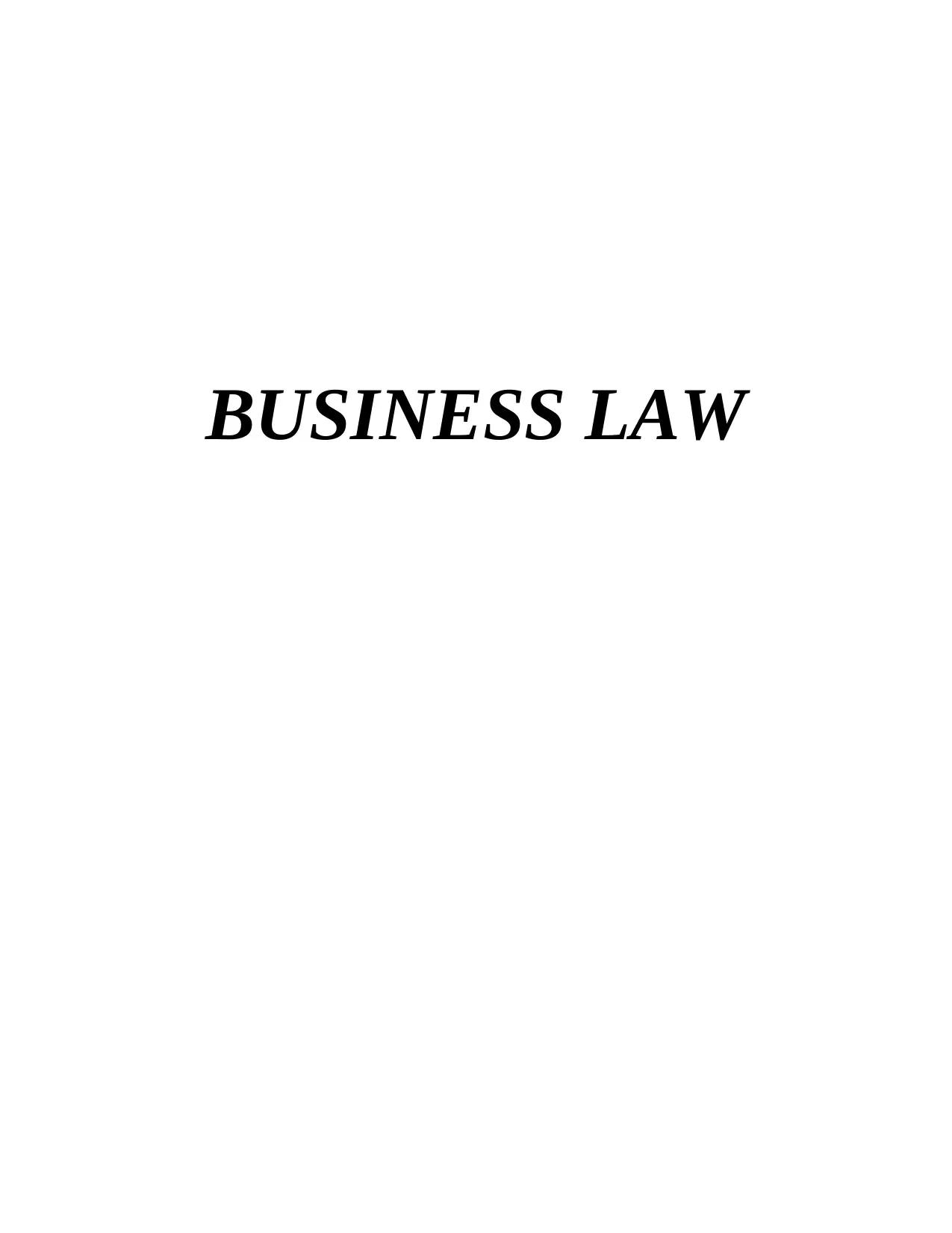
BUSINESS LAW
Paraphrase This Document
Need a fresh take? Get an instant paraphrase of this document with our AI Paraphraser
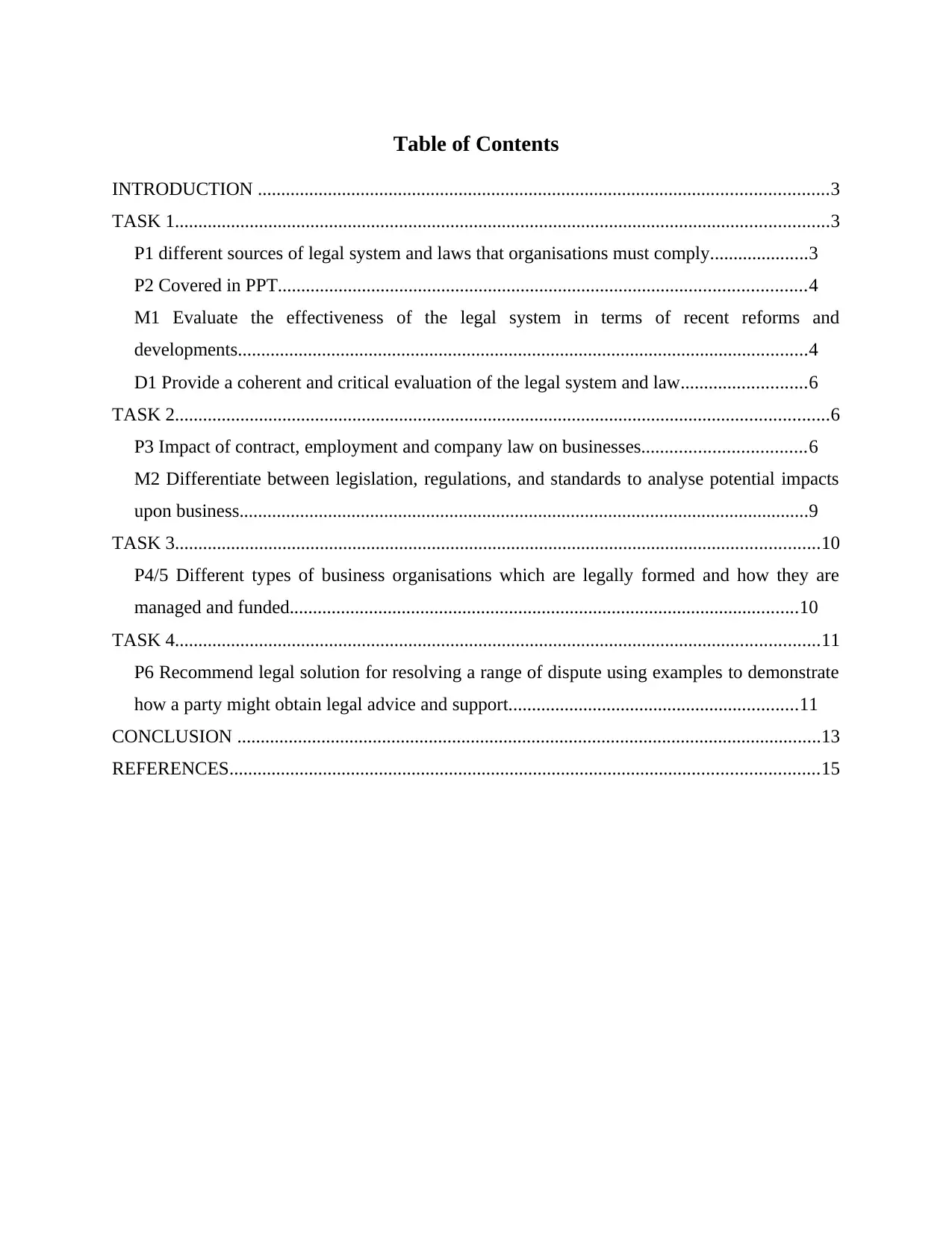
Table of Contents
INTRODUCTION ..........................................................................................................................3
TASK 1............................................................................................................................................3
P1 different sources of legal system and laws that organisations must comply.....................3
P2 Covered in PPT.................................................................................................................4
M1 Evaluate the effectiveness of the legal system in terms of recent reforms and
developments..........................................................................................................................4
D1 Provide a coherent and critical evaluation of the legal system and law...........................6
TASK 2............................................................................................................................................6
P3 Impact of contract, employment and company law on businesses...................................6
M2 Differentiate between legislation, regulations, and standards to analyse potential impacts
upon business..........................................................................................................................9
TASK 3..........................................................................................................................................10
P4/5 Different types of business organisations which are legally formed and how they are
managed and funded.............................................................................................................10
TASK 4..........................................................................................................................................11
P6 Recommend legal solution for resolving a range of dispute using examples to demonstrate
how a party might obtain legal advice and support..............................................................11
CONCLUSION .............................................................................................................................13
REFERENCES..............................................................................................................................15
INTRODUCTION ..........................................................................................................................3
TASK 1............................................................................................................................................3
P1 different sources of legal system and laws that organisations must comply.....................3
P2 Covered in PPT.................................................................................................................4
M1 Evaluate the effectiveness of the legal system in terms of recent reforms and
developments..........................................................................................................................4
D1 Provide a coherent and critical evaluation of the legal system and law...........................6
TASK 2............................................................................................................................................6
P3 Impact of contract, employment and company law on businesses...................................6
M2 Differentiate between legislation, regulations, and standards to analyse potential impacts
upon business..........................................................................................................................9
TASK 3..........................................................................................................................................10
P4/5 Different types of business organisations which are legally formed and how they are
managed and funded.............................................................................................................10
TASK 4..........................................................................................................................................11
P6 Recommend legal solution for resolving a range of dispute using examples to demonstrate
how a party might obtain legal advice and support..............................................................11
CONCLUSION .............................................................................................................................13
REFERENCES..............................................................................................................................15
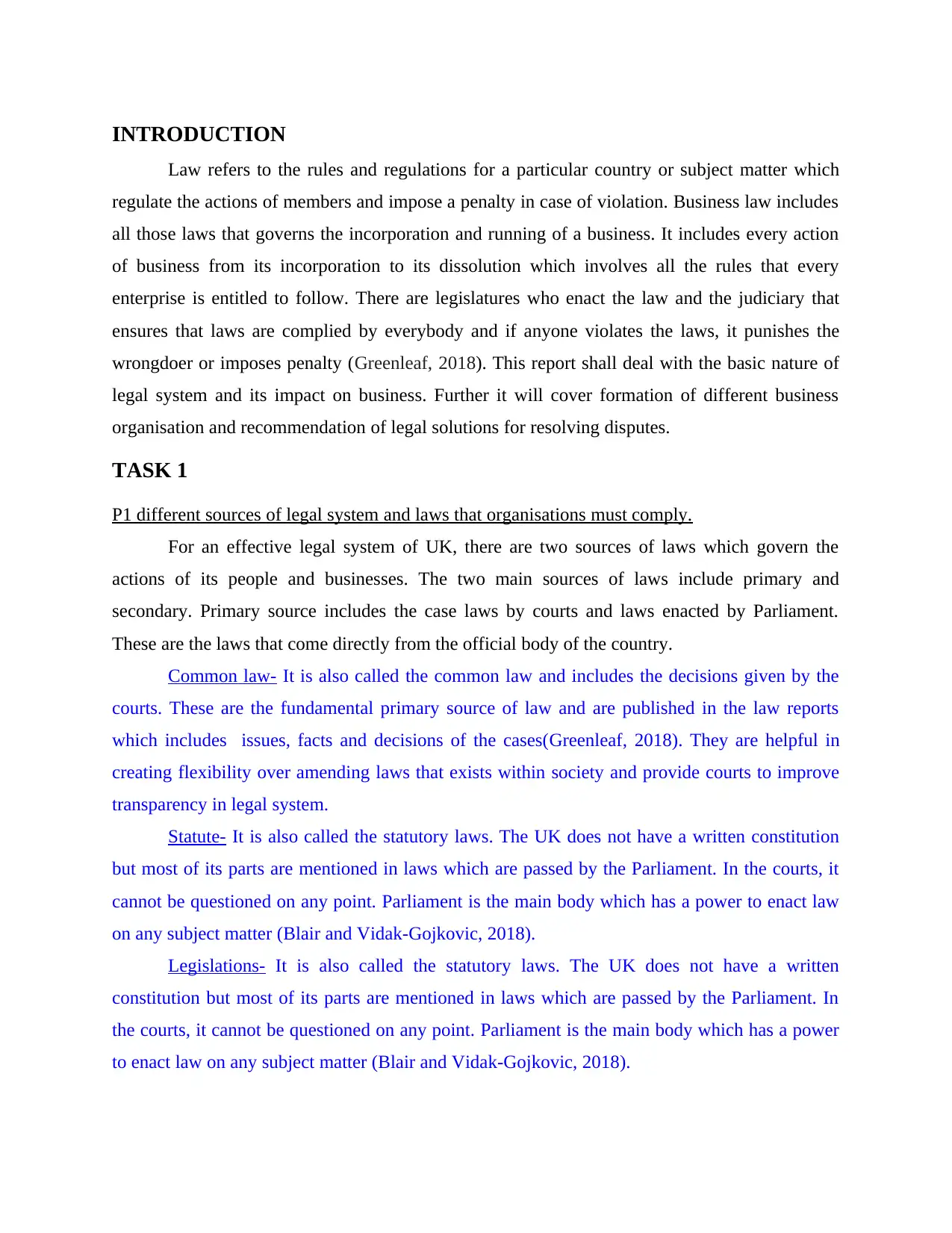
INTRODUCTION
Law refers to the rules and regulations for a particular country or subject matter which
regulate the actions of members and impose a penalty in case of violation. Business law includes
all those laws that governs the incorporation and running of a business. It includes every action
of business from its incorporation to its dissolution which involves all the rules that every
enterprise is entitled to follow. There are legislatures who enact the law and the judiciary that
ensures that laws are complied by everybody and if anyone violates the laws, it punishes the
wrongdoer or imposes penalty (Greenleaf, 2018). This report shall deal with the basic nature of
legal system and its impact on business. Further it will cover formation of different business
organisation and recommendation of legal solutions for resolving disputes.
TASK 1
P1 different sources of legal system and laws that organisations must comply.
For an effective legal system of UK, there are two sources of laws which govern the
actions of its people and businesses. The two main sources of laws include primary and
secondary. Primary source includes the case laws by courts and laws enacted by Parliament.
These are the laws that come directly from the official body of the country.
Common law- It is also called the common law and includes the decisions given by the
courts. These are the fundamental primary source of law and are published in the law reports
which includes issues, facts and decisions of the cases(Greenleaf, 2018). They are helpful in
creating flexibility over amending laws that exists within society and provide courts to improve
transparency in legal system.
Statute- It is also called the statutory laws. The UK does not have a written constitution
but most of its parts are mentioned in laws which are passed by the Parliament. In the courts, it
cannot be questioned on any point. Parliament is the main body which has a power to enact law
on any subject matter (Blair and Vidak-Gojkovic, 2018).
Legislations- It is also called the statutory laws. The UK does not have a written
constitution but most of its parts are mentioned in laws which are passed by the Parliament. In
the courts, it cannot be questioned on any point. Parliament is the main body which has a power
to enact law on any subject matter (Blair and Vidak-Gojkovic, 2018).
Law refers to the rules and regulations for a particular country or subject matter which
regulate the actions of members and impose a penalty in case of violation. Business law includes
all those laws that governs the incorporation and running of a business. It includes every action
of business from its incorporation to its dissolution which involves all the rules that every
enterprise is entitled to follow. There are legislatures who enact the law and the judiciary that
ensures that laws are complied by everybody and if anyone violates the laws, it punishes the
wrongdoer or imposes penalty (Greenleaf, 2018). This report shall deal with the basic nature of
legal system and its impact on business. Further it will cover formation of different business
organisation and recommendation of legal solutions for resolving disputes.
TASK 1
P1 different sources of legal system and laws that organisations must comply.
For an effective legal system of UK, there are two sources of laws which govern the
actions of its people and businesses. The two main sources of laws include primary and
secondary. Primary source includes the case laws by courts and laws enacted by Parliament.
These are the laws that come directly from the official body of the country.
Common law- It is also called the common law and includes the decisions given by the
courts. These are the fundamental primary source of law and are published in the law reports
which includes issues, facts and decisions of the cases(Greenleaf, 2018). They are helpful in
creating flexibility over amending laws that exists within society and provide courts to improve
transparency in legal system.
Statute- It is also called the statutory laws. The UK does not have a written constitution
but most of its parts are mentioned in laws which are passed by the Parliament. In the courts, it
cannot be questioned on any point. Parliament is the main body which has a power to enact law
on any subject matter (Blair and Vidak-Gojkovic, 2018).
Legislations- It is also called the statutory laws. The UK does not have a written
constitution but most of its parts are mentioned in laws which are passed by the Parliament. In
the courts, it cannot be questioned on any point. Parliament is the main body which has a power
to enact law on any subject matter (Blair and Vidak-Gojkovic, 2018).
⊘ This is a preview!⊘
Do you want full access?
Subscribe today to unlock all pages.

Trusted by 1+ million students worldwide
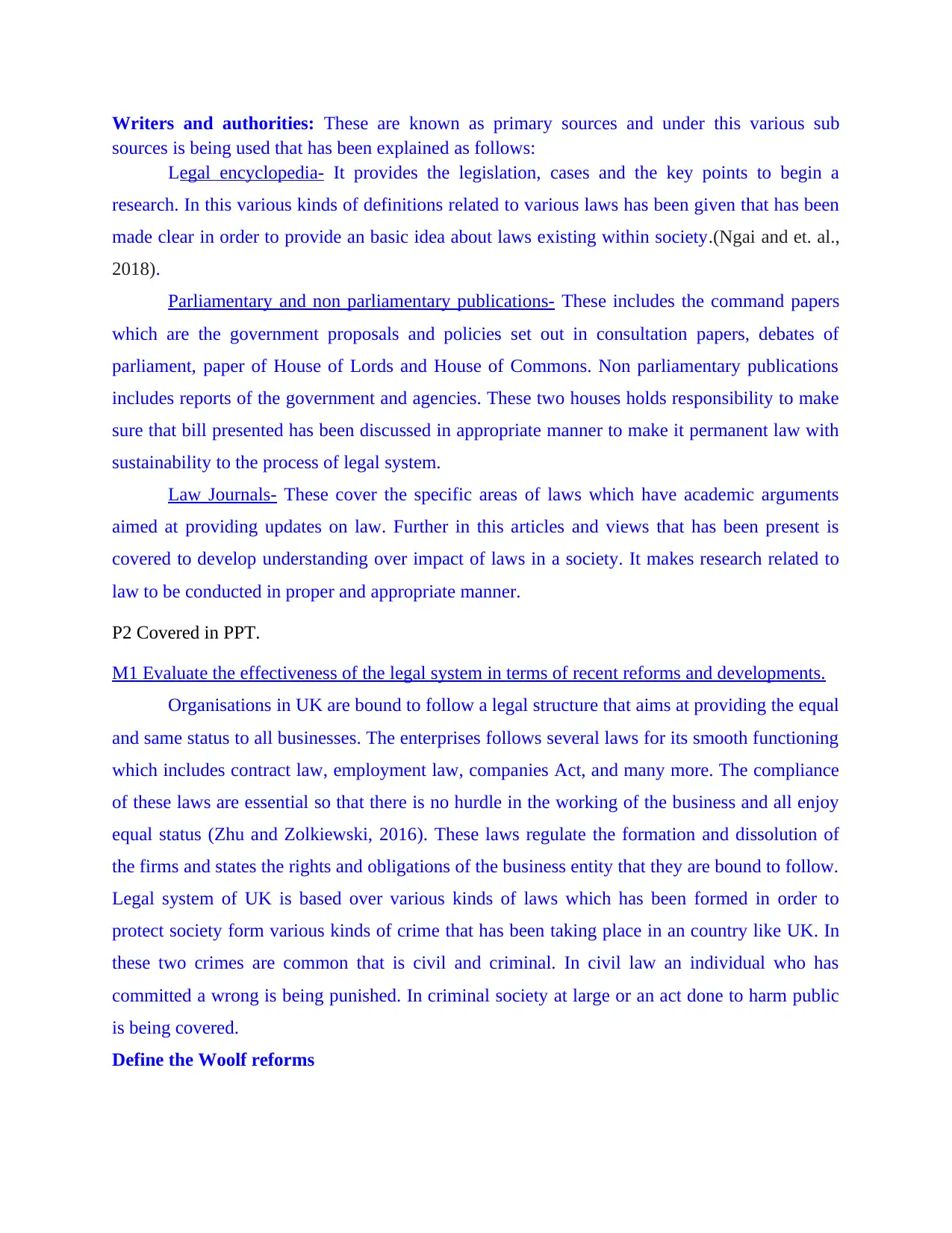
Writers and authorities: These are known as primary sources and under this various sub
sources is being used that has been explained as follows:
Legal encyclopedia- It provides the legislation, cases and the key points to begin a
research. In this various kinds of definitions related to various laws has been given that has been
made clear in order to provide an basic idea about laws existing within society.(Ngai and et. al.,
2018).
Parliamentary and non parliamentary publications- These includes the command papers
which are the government proposals and policies set out in consultation papers, debates of
parliament, paper of House of Lords and House of Commons. Non parliamentary publications
includes reports of the government and agencies. These two houses holds responsibility to make
sure that bill presented has been discussed in appropriate manner to make it permanent law with
sustainability to the process of legal system.
Law Journals- These cover the specific areas of laws which have academic arguments
aimed at providing updates on law. Further in this articles and views that has been present is
covered to develop understanding over impact of laws in a society. It makes research related to
law to be conducted in proper and appropriate manner.
P2 Covered in PPT.
M1 Evaluate the effectiveness of the legal system in terms of recent reforms and developments.
Organisations in UK are bound to follow a legal structure that aims at providing the equal
and same status to all businesses. The enterprises follows several laws for its smooth functioning
which includes contract law, employment law, companies Act, and many more. The compliance
of these laws are essential so that there is no hurdle in the working of the business and all enjoy
equal status (Zhu and Zolkiewski, 2016). These laws regulate the formation and dissolution of
the firms and states the rights and obligations of the business entity that they are bound to follow.
Legal system of UK is based over various kinds of laws which has been formed in order to
protect society form various kinds of crime that has been taking place in an country like UK. In
these two crimes are common that is civil and criminal. In civil law an individual who has
committed a wrong is being punished. In criminal society at large or an act done to harm public
is being covered.
Define the Woolf reforms
sources is being used that has been explained as follows:
Legal encyclopedia- It provides the legislation, cases and the key points to begin a
research. In this various kinds of definitions related to various laws has been given that has been
made clear in order to provide an basic idea about laws existing within society.(Ngai and et. al.,
2018).
Parliamentary and non parliamentary publications- These includes the command papers
which are the government proposals and policies set out in consultation papers, debates of
parliament, paper of House of Lords and House of Commons. Non parliamentary publications
includes reports of the government and agencies. These two houses holds responsibility to make
sure that bill presented has been discussed in appropriate manner to make it permanent law with
sustainability to the process of legal system.
Law Journals- These cover the specific areas of laws which have academic arguments
aimed at providing updates on law. Further in this articles and views that has been present is
covered to develop understanding over impact of laws in a society. It makes research related to
law to be conducted in proper and appropriate manner.
P2 Covered in PPT.
M1 Evaluate the effectiveness of the legal system in terms of recent reforms and developments.
Organisations in UK are bound to follow a legal structure that aims at providing the equal
and same status to all businesses. The enterprises follows several laws for its smooth functioning
which includes contract law, employment law, companies Act, and many more. The compliance
of these laws are essential so that there is no hurdle in the working of the business and all enjoy
equal status (Zhu and Zolkiewski, 2016). These laws regulate the formation and dissolution of
the firms and states the rights and obligations of the business entity that they are bound to follow.
Legal system of UK is based over various kinds of laws which has been formed in order to
protect society form various kinds of crime that has been taking place in an country like UK. In
these two crimes are common that is civil and criminal. In civil law an individual who has
committed a wrong is being punished. In criminal society at large or an act done to harm public
is being covered.
Define the Woolf reforms
Paraphrase This Document
Need a fresh take? Get an instant paraphrase of this document with our AI Paraphraser
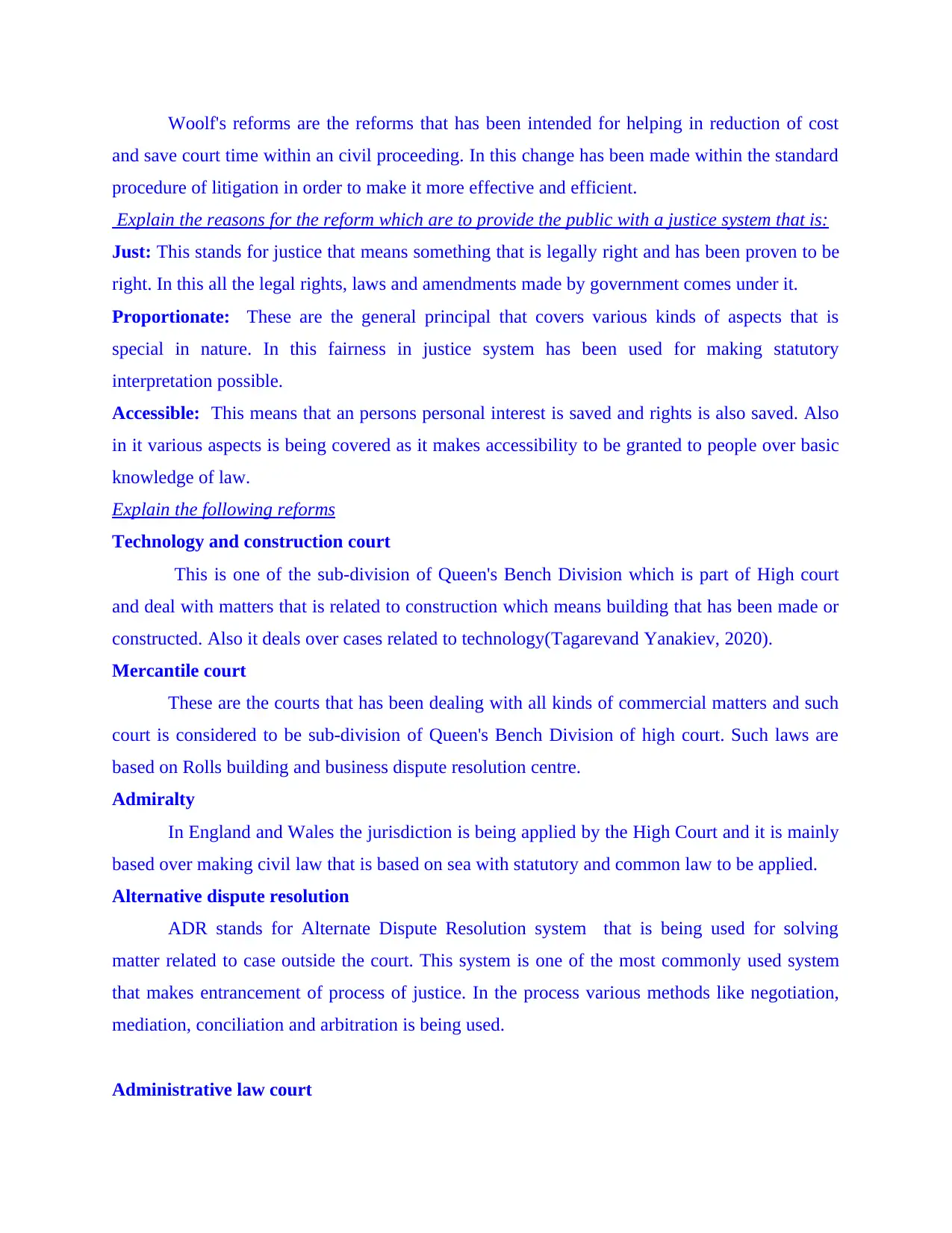
Woolf's reforms are the reforms that has been intended for helping in reduction of cost
and save court time within an civil proceeding. In this change has been made within the standard
procedure of litigation in order to make it more effective and efficient.
Explain the reasons for the reform which are to provide the public with a justice system that is:
Just: This stands for justice that means something that is legally right and has been proven to be
right. In this all the legal rights, laws and amendments made by government comes under it.
Proportionate: These are the general principal that covers various kinds of aspects that is
special in nature. In this fairness in justice system has been used for making statutory
interpretation possible.
Accessible: This means that an persons personal interest is saved and rights is also saved. Also
in it various aspects is being covered as it makes accessibility to be granted to people over basic
knowledge of law.
Explain the following reforms
Technology and construction court
This is one of the sub-division of Queen's Bench Division which is part of High court
and deal with matters that is related to construction which means building that has been made or
constructed. Also it deals over cases related to technology(Tagarevand Yanakiev, 2020).
Mercantile court
These are the courts that has been dealing with all kinds of commercial matters and such
court is considered to be sub-division of Queen's Bench Division of high court. Such laws are
based on Rolls building and business dispute resolution centre.
Admiralty
In England and Wales the jurisdiction is being applied by the High Court and it is mainly
based over making civil law that is based on sea with statutory and common law to be applied.
Alternative dispute resolution
ADR stands for Alternate Dispute Resolution system that is being used for solving
matter related to case outside the court. This system is one of the most commonly used system
that makes entrancement of process of justice. In the process various methods like negotiation,
mediation, conciliation and arbitration is being used.
Administrative law court
and save court time within an civil proceeding. In this change has been made within the standard
procedure of litigation in order to make it more effective and efficient.
Explain the reasons for the reform which are to provide the public with a justice system that is:
Just: This stands for justice that means something that is legally right and has been proven to be
right. In this all the legal rights, laws and amendments made by government comes under it.
Proportionate: These are the general principal that covers various kinds of aspects that is
special in nature. In this fairness in justice system has been used for making statutory
interpretation possible.
Accessible: This means that an persons personal interest is saved and rights is also saved. Also
in it various aspects is being covered as it makes accessibility to be granted to people over basic
knowledge of law.
Explain the following reforms
Technology and construction court
This is one of the sub-division of Queen's Bench Division which is part of High court
and deal with matters that is related to construction which means building that has been made or
constructed. Also it deals over cases related to technology(Tagarevand Yanakiev, 2020).
Mercantile court
These are the courts that has been dealing with all kinds of commercial matters and such
court is considered to be sub-division of Queen's Bench Division of high court. Such laws are
based on Rolls building and business dispute resolution centre.
Admiralty
In England and Wales the jurisdiction is being applied by the High Court and it is mainly
based over making civil law that is based on sea with statutory and common law to be applied.
Alternative dispute resolution
ADR stands for Alternate Dispute Resolution system that is being used for solving
matter related to case outside the court. This system is one of the most commonly used system
that makes entrancement of process of justice. In the process various methods like negotiation,
mediation, conciliation and arbitration is being used.
Administrative law court
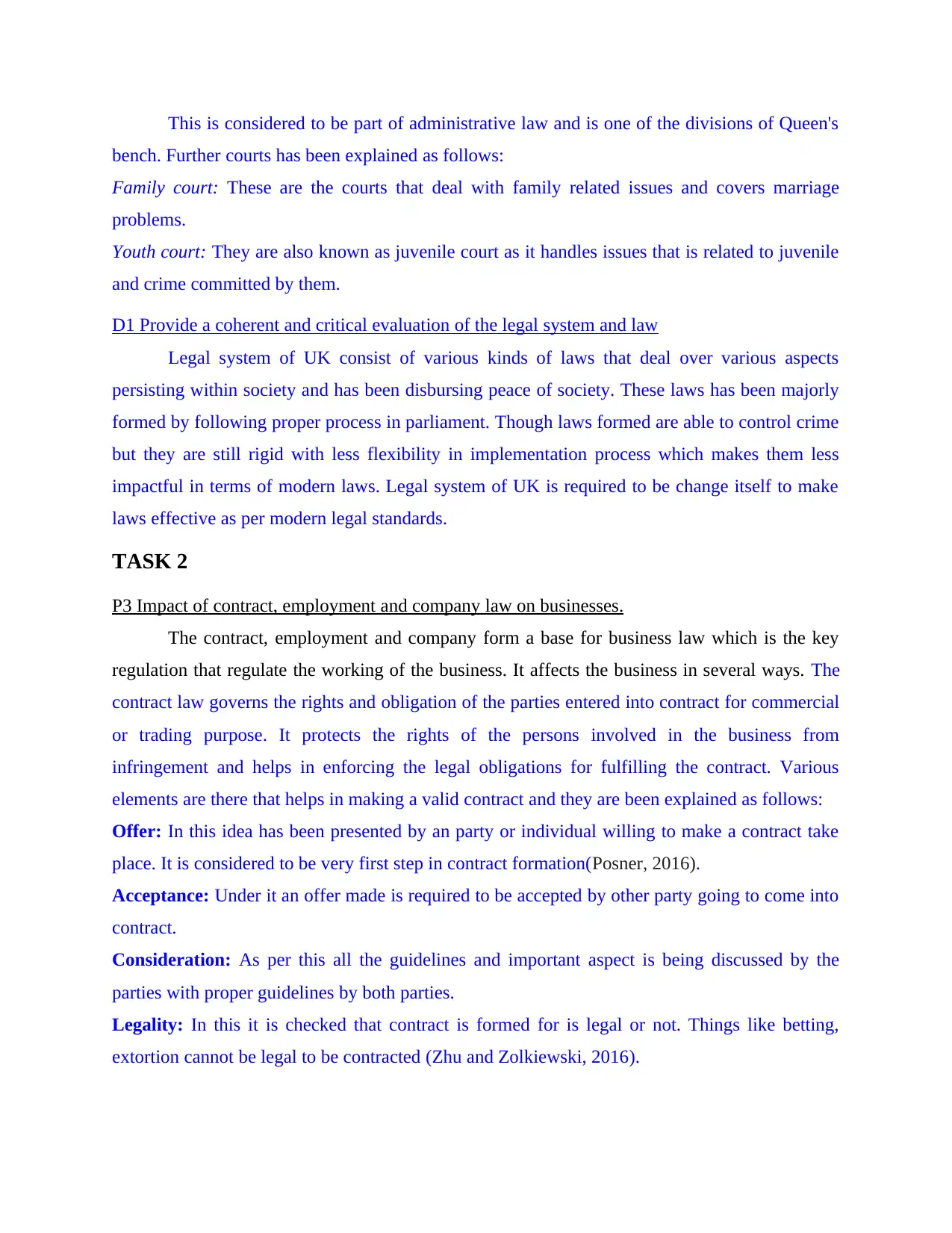
This is considered to be part of administrative law and is one of the divisions of Queen's
bench. Further courts has been explained as follows:
Family court: These are the courts that deal with family related issues and covers marriage
problems.
Youth court: They are also known as juvenile court as it handles issues that is related to juvenile
and crime committed by them.
D1 Provide a coherent and critical evaluation of the legal system and law
Legal system of UK consist of various kinds of laws that deal over various aspects
persisting within society and has been disbursing peace of society. These laws has been majorly
formed by following proper process in parliament. Though laws formed are able to control crime
but they are still rigid with less flexibility in implementation process which makes them less
impactful in terms of modern laws. Legal system of UK is required to be change itself to make
laws effective as per modern legal standards.
TASK 2
P3 Impact of contract, employment and company law on businesses.
The contract, employment and company form a base for business law which is the key
regulation that regulate the working of the business. It affects the business in several ways. The
contract law governs the rights and obligation of the parties entered into contract for commercial
or trading purpose. It protects the rights of the persons involved in the business from
infringement and helps in enforcing the legal obligations for fulfilling the contract. Various
elements are there that helps in making a valid contract and they are been explained as follows:
Offer: In this idea has been presented by an party or individual willing to make a contract take
place. It is considered to be very first step in contract formation(Posner, 2016).
Acceptance: Under it an offer made is required to be accepted by other party going to come into
contract.
Consideration: As per this all the guidelines and important aspect is being discussed by the
parties with proper guidelines by both parties.
Legality: In this it is checked that contract is formed for is legal or not. Things like betting,
extortion cannot be legal to be contracted (Zhu and Zolkiewski, 2016).
bench. Further courts has been explained as follows:
Family court: These are the courts that deal with family related issues and covers marriage
problems.
Youth court: They are also known as juvenile court as it handles issues that is related to juvenile
and crime committed by them.
D1 Provide a coherent and critical evaluation of the legal system and law
Legal system of UK consist of various kinds of laws that deal over various aspects
persisting within society and has been disbursing peace of society. These laws has been majorly
formed by following proper process in parliament. Though laws formed are able to control crime
but they are still rigid with less flexibility in implementation process which makes them less
impactful in terms of modern laws. Legal system of UK is required to be change itself to make
laws effective as per modern legal standards.
TASK 2
P3 Impact of contract, employment and company law on businesses.
The contract, employment and company form a base for business law which is the key
regulation that regulate the working of the business. It affects the business in several ways. The
contract law governs the rights and obligation of the parties entered into contract for commercial
or trading purpose. It protects the rights of the persons involved in the business from
infringement and helps in enforcing the legal obligations for fulfilling the contract. Various
elements are there that helps in making a valid contract and they are been explained as follows:
Offer: In this idea has been presented by an party or individual willing to make a contract take
place. It is considered to be very first step in contract formation(Posner, 2016).
Acceptance: Under it an offer made is required to be accepted by other party going to come into
contract.
Consideration: As per this all the guidelines and important aspect is being discussed by the
parties with proper guidelines by both parties.
Legality: In this it is checked that contract is formed for is legal or not. Things like betting,
extortion cannot be legal to be contracted (Zhu and Zolkiewski, 2016).
⊘ This is a preview!⊘
Do you want full access?
Subscribe today to unlock all pages.

Trusted by 1+ million students worldwide
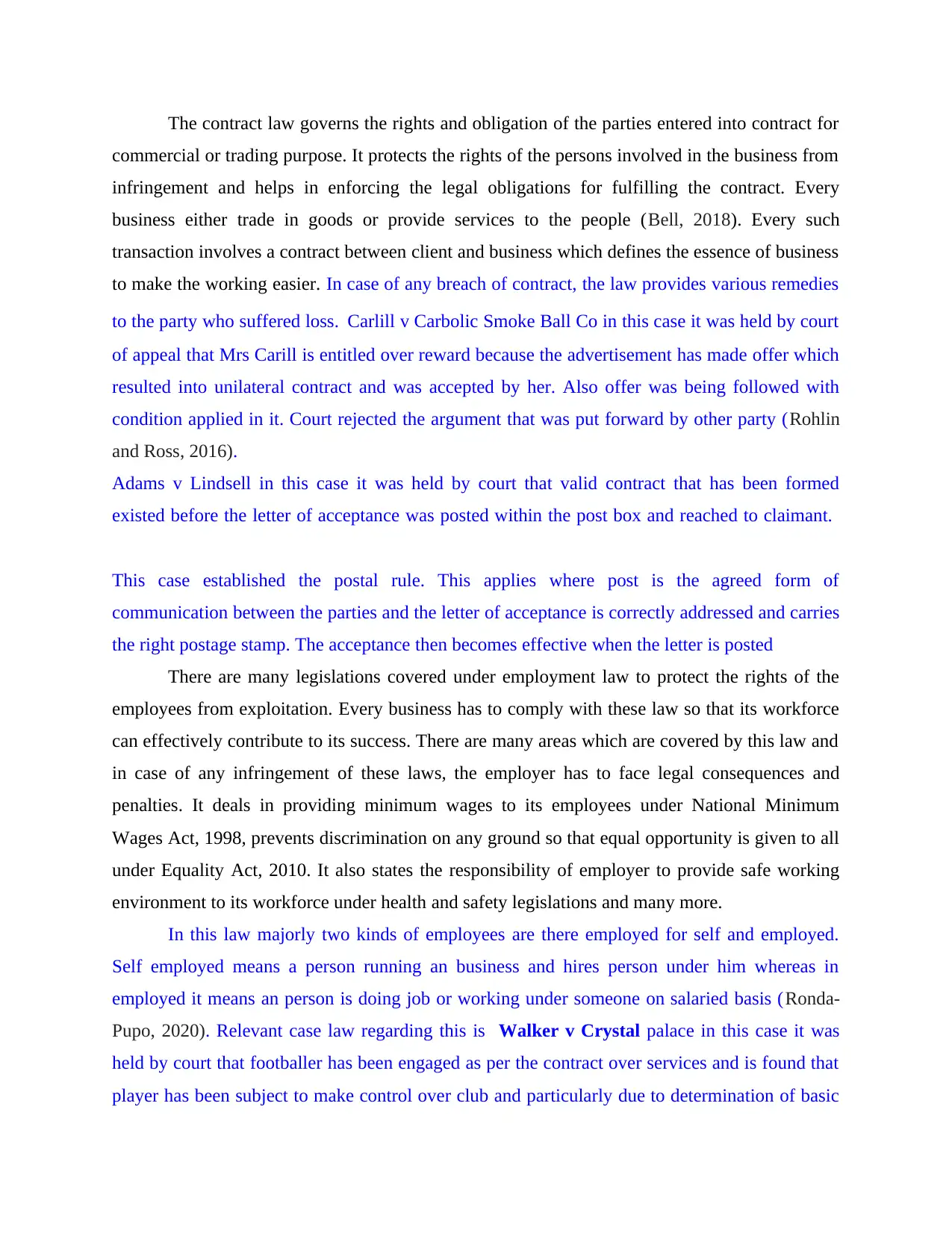
The contract law governs the rights and obligation of the parties entered into contract for
commercial or trading purpose. It protects the rights of the persons involved in the business from
infringement and helps in enforcing the legal obligations for fulfilling the contract. Every
business either trade in goods or provide services to the people (Bell, 2018). Every such
transaction involves a contract between client and business which defines the essence of business
to make the working easier. In case of any breach of contract, the law provides various remedies
to the party who suffered loss. Carlill v Carbolic Smoke Ball Co in this case it was held by court
of appeal that Mrs Carill is entitled over reward because the advertisement has made offer which
resulted into unilateral contract and was accepted by her. Also offer was being followed with
condition applied in it. Court rejected the argument that was put forward by other party (Rohlin
and Ross, 2016).
Adams v Lindsell in this case it was held by court that valid contract that has been formed
existed before the letter of acceptance was posted within the post box and reached to claimant.
This case established the postal rule. This applies where post is the agreed form of
communication between the parties and the letter of acceptance is correctly addressed and carries
the right postage stamp. The acceptance then becomes effective when the letter is posted
There are many legislations covered under employment law to protect the rights of the
employees from exploitation. Every business has to comply with these law so that its workforce
can effectively contribute to its success. There are many areas which are covered by this law and
in case of any infringement of these laws, the employer has to face legal consequences and
penalties. It deals in providing minimum wages to its employees under National Minimum
Wages Act, 1998, prevents discrimination on any ground so that equal opportunity is given to all
under Equality Act, 2010. It also states the responsibility of employer to provide safe working
environment to its workforce under health and safety legislations and many more.
In this law majorly two kinds of employees are there employed for self and employed.
Self employed means a person running an business and hires person under him whereas in
employed it means an person is doing job or working under someone on salaried basis (Ronda-
Pupo, 2020). Relevant case law regarding this is Walker v Crystal palace in this case it was
held by court that footballer has been engaged as per the contract over services and is found that
player has been subject to make control over club and particularly due to determination of basic
commercial or trading purpose. It protects the rights of the persons involved in the business from
infringement and helps in enforcing the legal obligations for fulfilling the contract. Every
business either trade in goods or provide services to the people (Bell, 2018). Every such
transaction involves a contract between client and business which defines the essence of business
to make the working easier. In case of any breach of contract, the law provides various remedies
to the party who suffered loss. Carlill v Carbolic Smoke Ball Co in this case it was held by court
of appeal that Mrs Carill is entitled over reward because the advertisement has made offer which
resulted into unilateral contract and was accepted by her. Also offer was being followed with
condition applied in it. Court rejected the argument that was put forward by other party (Rohlin
and Ross, 2016).
Adams v Lindsell in this case it was held by court that valid contract that has been formed
existed before the letter of acceptance was posted within the post box and reached to claimant.
This case established the postal rule. This applies where post is the agreed form of
communication between the parties and the letter of acceptance is correctly addressed and carries
the right postage stamp. The acceptance then becomes effective when the letter is posted
There are many legislations covered under employment law to protect the rights of the
employees from exploitation. Every business has to comply with these law so that its workforce
can effectively contribute to its success. There are many areas which are covered by this law and
in case of any infringement of these laws, the employer has to face legal consequences and
penalties. It deals in providing minimum wages to its employees under National Minimum
Wages Act, 1998, prevents discrimination on any ground so that equal opportunity is given to all
under Equality Act, 2010. It also states the responsibility of employer to provide safe working
environment to its workforce under health and safety legislations and many more.
In this law majorly two kinds of employees are there employed for self and employed.
Self employed means a person running an business and hires person under him whereas in
employed it means an person is doing job or working under someone on salaried basis (Ronda-
Pupo, 2020). Relevant case law regarding this is Walker v Crystal palace in this case it was
held by court that footballer has been engaged as per the contract over services and is found that
player has been subject to make control over club and particularly due to determination of basic
Paraphrase This Document
Need a fresh take? Get an instant paraphrase of this document with our AI Paraphraser
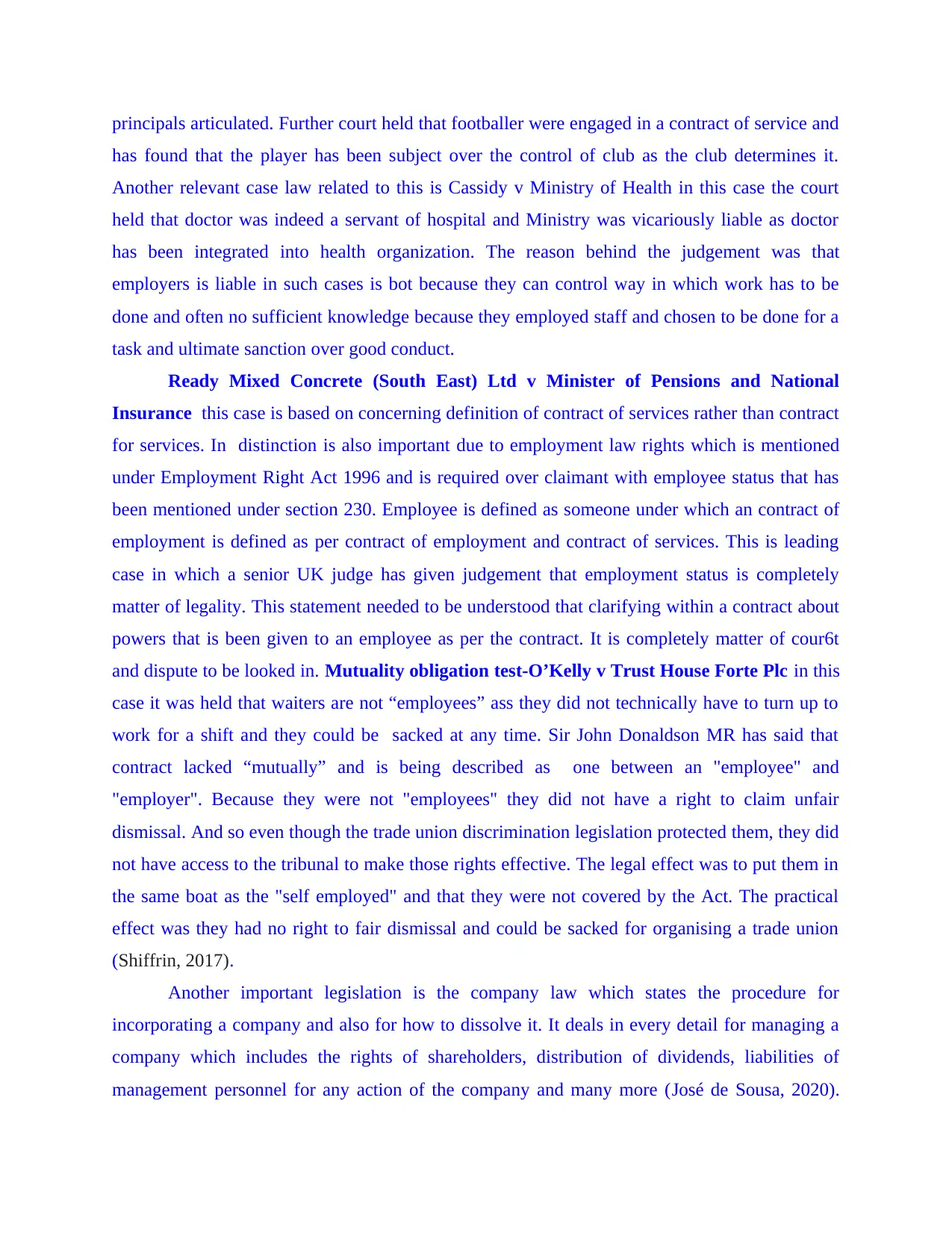
principals articulated. Further court held that footballer were engaged in a contract of service and
has found that the player has been subject over the control of club as the club determines it.
Another relevant case law related to this is Cassidy v Ministry of Health in this case the court
held that doctor was indeed a servant of hospital and Ministry was vicariously liable as doctor
has been integrated into health organization. The reason behind the judgement was that
employers is liable in such cases is bot because they can control way in which work has to be
done and often no sufficient knowledge because they employed staff and chosen to be done for a
task and ultimate sanction over good conduct.
Ready Mixed Concrete (South East) Ltd v Minister of Pensions and National
Insurance this case is based on concerning definition of contract of services rather than contract
for services. In distinction is also important due to employment law rights which is mentioned
under Employment Right Act 1996 and is required over claimant with employee status that has
been mentioned under section 230. Employee is defined as someone under which an contract of
employment is defined as per contract of employment and contract of services. This is leading
case in which a senior UK judge has given judgement that employment status is completely
matter of legality. This statement needed to be understood that clarifying within a contract about
powers that is been given to an employee as per the contract. It is completely matter of cour6t
and dispute to be looked in. Mutuality obligation test-O’Kelly v Trust House Forte Plc in this
case it was held that waiters are not “employees” ass they did not technically have to turn up to
work for a shift and they could be sacked at any time. Sir John Donaldson MR has said that
contract lacked “mutually” and is being described as one between an "employee" and
"employer". Because they were not "employees" they did not have a right to claim unfair
dismissal. And so even though the trade union discrimination legislation protected them, they did
not have access to the tribunal to make those rights effective. The legal effect was to put them in
the same boat as the "self employed" and that they were not covered by the Act. The practical
effect was they had no right to fair dismissal and could be sacked for organising a trade union
(Shiffrin, 2017).
Another important legislation is the company law which states the procedure for
incorporating a company and also for how to dissolve it. It deals in every detail for managing a
company which includes the rights of shareholders, distribution of dividends, liabilities of
management personnel for any action of the company and many more (José de Sousa, 2020).
has found that the player has been subject over the control of club as the club determines it.
Another relevant case law related to this is Cassidy v Ministry of Health in this case the court
held that doctor was indeed a servant of hospital and Ministry was vicariously liable as doctor
has been integrated into health organization. The reason behind the judgement was that
employers is liable in such cases is bot because they can control way in which work has to be
done and often no sufficient knowledge because they employed staff and chosen to be done for a
task and ultimate sanction over good conduct.
Ready Mixed Concrete (South East) Ltd v Minister of Pensions and National
Insurance this case is based on concerning definition of contract of services rather than contract
for services. In distinction is also important due to employment law rights which is mentioned
under Employment Right Act 1996 and is required over claimant with employee status that has
been mentioned under section 230. Employee is defined as someone under which an contract of
employment is defined as per contract of employment and contract of services. This is leading
case in which a senior UK judge has given judgement that employment status is completely
matter of legality. This statement needed to be understood that clarifying within a contract about
powers that is been given to an employee as per the contract. It is completely matter of cour6t
and dispute to be looked in. Mutuality obligation test-O’Kelly v Trust House Forte Plc in this
case it was held that waiters are not “employees” ass they did not technically have to turn up to
work for a shift and they could be sacked at any time. Sir John Donaldson MR has said that
contract lacked “mutually” and is being described as one between an "employee" and
"employer". Because they were not "employees" they did not have a right to claim unfair
dismissal. And so even though the trade union discrimination legislation protected them, they did
not have access to the tribunal to make those rights effective. The legal effect was to put them in
the same boat as the "self employed" and that they were not covered by the Act. The practical
effect was they had no right to fair dismissal and could be sacked for organising a trade union
(Shiffrin, 2017).
Another important legislation is the company law which states the procedure for
incorporating a company and also for how to dissolve it. It deals in every detail for managing a
company which includes the rights of shareholders, distribution of dividends, liabilities of
management personnel for any action of the company and many more (José de Sousa, 2020).
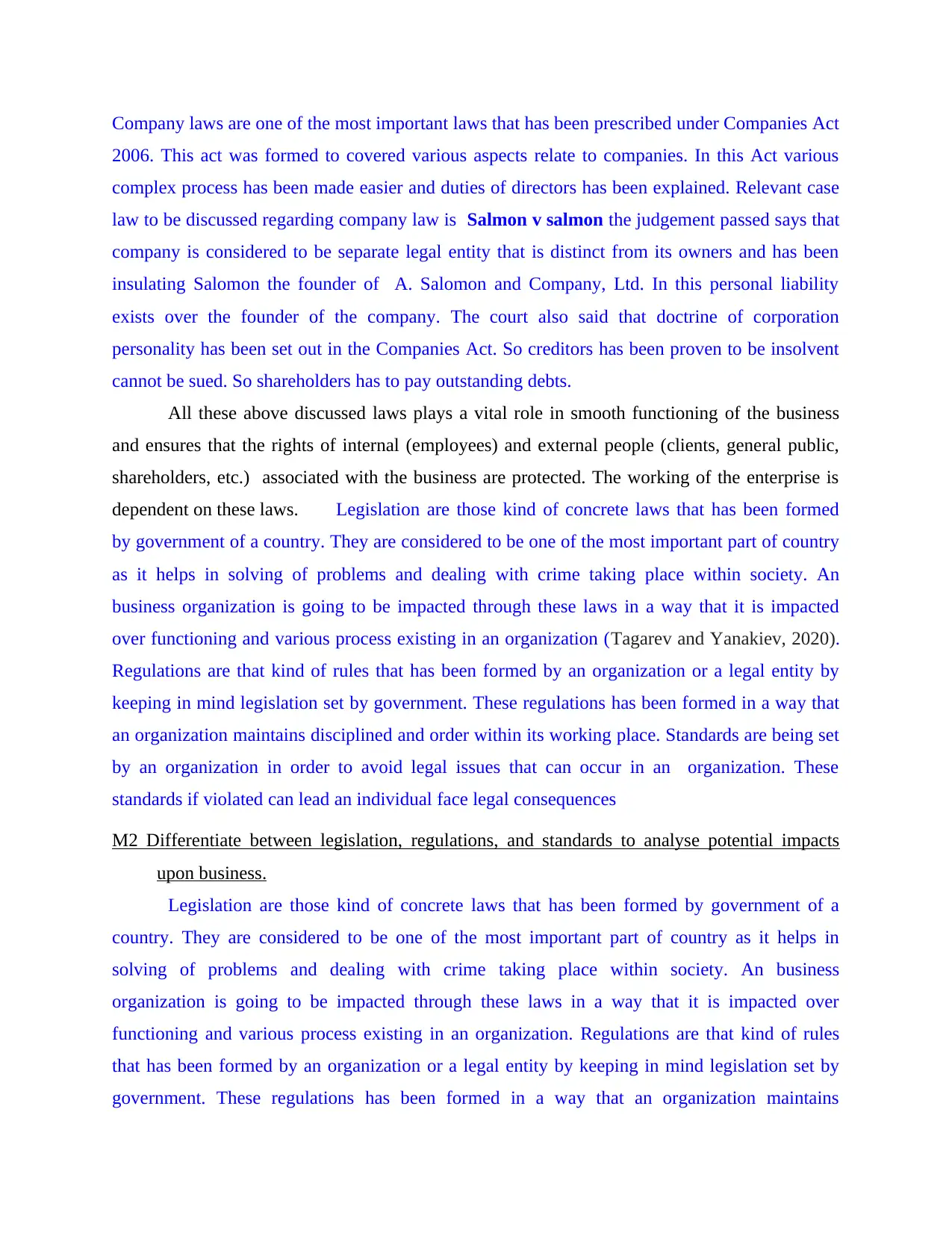
Company laws are one of the most important laws that has been prescribed under Companies Act
2006. This act was formed to covered various aspects relate to companies. In this Act various
complex process has been made easier and duties of directors has been explained. Relevant case
law to be discussed regarding company law is Salmon v salmon the judgement passed says that
company is considered to be separate legal entity that is distinct from its owners and has been
insulating Salomon the founder of A. Salomon and Company, Ltd. In this personal liability
exists over the founder of the company. The court also said that doctrine of corporation
personality has been set out in the Companies Act. So creditors has been proven to be insolvent
cannot be sued. So shareholders has to pay outstanding debts.
All these above discussed laws plays a vital role in smooth functioning of the business
and ensures that the rights of internal (employees) and external people (clients, general public,
shareholders, etc.) associated with the business are protected. The working of the enterprise is
dependent on these laws. Legislation are those kind of concrete laws that has been formed
by government of a country. They are considered to be one of the most important part of country
as it helps in solving of problems and dealing with crime taking place within society. An
business organization is going to be impacted through these laws in a way that it is impacted
over functioning and various process existing in an organization (Tagarev and Yanakiev, 2020).
Regulations are that kind of rules that has been formed by an organization or a legal entity by
keeping in mind legislation set by government. These regulations has been formed in a way that
an organization maintains disciplined and order within its working place. Standards are being set
by an organization in order to avoid legal issues that can occur in an organization. These
standards if violated can lead an individual face legal consequences
M2 Differentiate between legislation, regulations, and standards to analyse potential impacts
upon business.
Legislation are those kind of concrete laws that has been formed by government of a
country. They are considered to be one of the most important part of country as it helps in
solving of problems and dealing with crime taking place within society. An business
organization is going to be impacted through these laws in a way that it is impacted over
functioning and various process existing in an organization. Regulations are that kind of rules
that has been formed by an organization or a legal entity by keeping in mind legislation set by
government. These regulations has been formed in a way that an organization maintains
2006. This act was formed to covered various aspects relate to companies. In this Act various
complex process has been made easier and duties of directors has been explained. Relevant case
law to be discussed regarding company law is Salmon v salmon the judgement passed says that
company is considered to be separate legal entity that is distinct from its owners and has been
insulating Salomon the founder of A. Salomon and Company, Ltd. In this personal liability
exists over the founder of the company. The court also said that doctrine of corporation
personality has been set out in the Companies Act. So creditors has been proven to be insolvent
cannot be sued. So shareholders has to pay outstanding debts.
All these above discussed laws plays a vital role in smooth functioning of the business
and ensures that the rights of internal (employees) and external people (clients, general public,
shareholders, etc.) associated with the business are protected. The working of the enterprise is
dependent on these laws. Legislation are those kind of concrete laws that has been formed
by government of a country. They are considered to be one of the most important part of country
as it helps in solving of problems and dealing with crime taking place within society. An
business organization is going to be impacted through these laws in a way that it is impacted
over functioning and various process existing in an organization (Tagarev and Yanakiev, 2020).
Regulations are that kind of rules that has been formed by an organization or a legal entity by
keeping in mind legislation set by government. These regulations has been formed in a way that
an organization maintains disciplined and order within its working place. Standards are being set
by an organization in order to avoid legal issues that can occur in an organization. These
standards if violated can lead an individual face legal consequences
M2 Differentiate between legislation, regulations, and standards to analyse potential impacts
upon business.
Legislation are those kind of concrete laws that has been formed by government of a
country. They are considered to be one of the most important part of country as it helps in
solving of problems and dealing with crime taking place within society. An business
organization is going to be impacted through these laws in a way that it is impacted over
functioning and various process existing in an organization. Regulations are that kind of rules
that has been formed by an organization or a legal entity by keeping in mind legislation set by
government. These regulations has been formed in a way that an organization maintains
⊘ This is a preview!⊘
Do you want full access?
Subscribe today to unlock all pages.

Trusted by 1+ million students worldwide
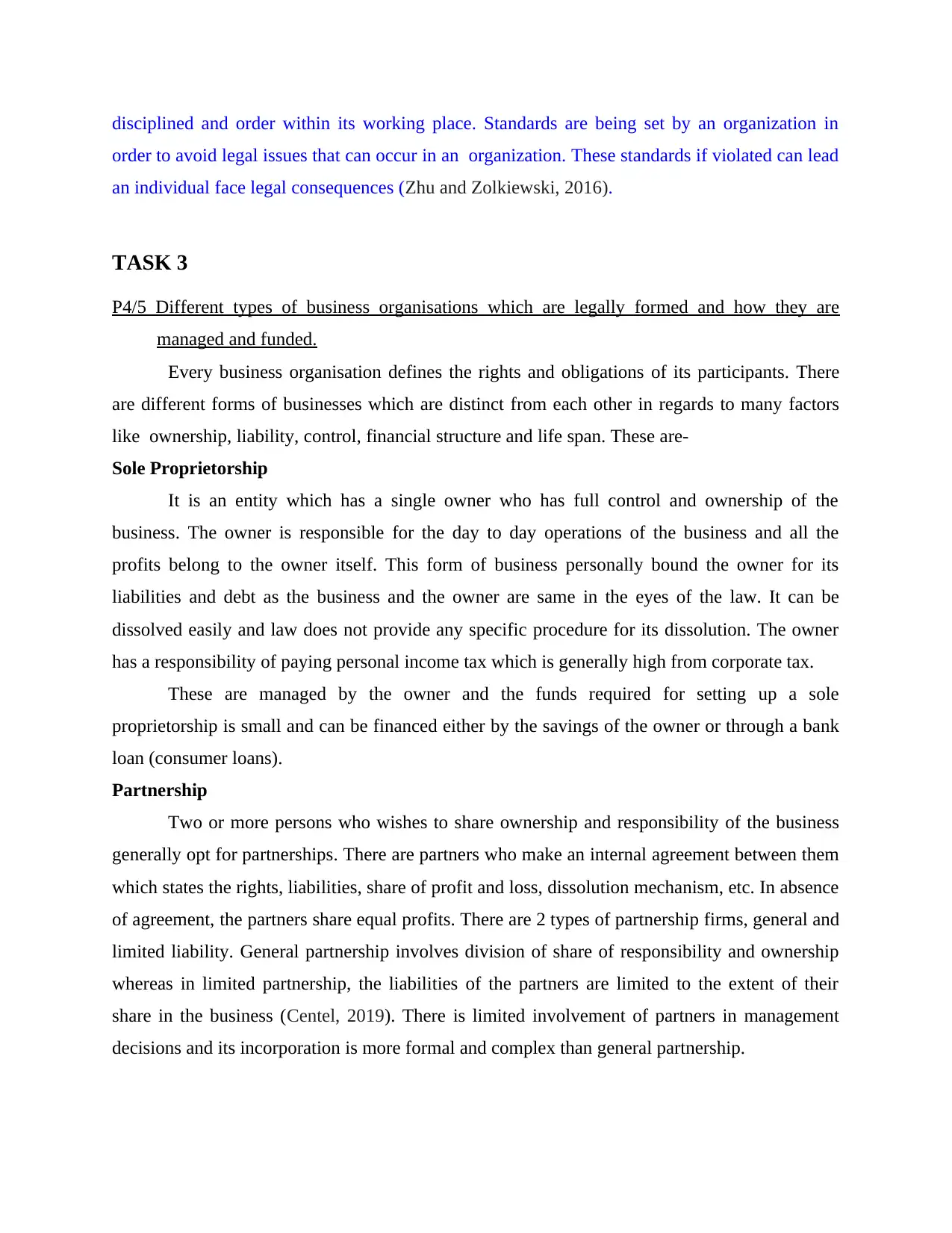
disciplined and order within its working place. Standards are being set by an organization in
order to avoid legal issues that can occur in an organization. These standards if violated can lead
an individual face legal consequences (Zhu and Zolkiewski, 2016).
TASK 3
P4/5 Different types of business organisations which are legally formed and how they are
managed and funded.
Every business organisation defines the rights and obligations of its participants. There
are different forms of businesses which are distinct from each other in regards to many factors
like ownership, liability, control, financial structure and life span. These are-
Sole Proprietorship
It is an entity which has a single owner who has full control and ownership of the
business. The owner is responsible for the day to day operations of the business and all the
profits belong to the owner itself. This form of business personally bound the owner for its
liabilities and debt as the business and the owner are same in the eyes of the law. It can be
dissolved easily and law does not provide any specific procedure for its dissolution. The owner
has a responsibility of paying personal income tax which is generally high from corporate tax.
These are managed by the owner and the funds required for setting up a sole
proprietorship is small and can be financed either by the savings of the owner or through a bank
loan (consumer loans).
Partnership
Two or more persons who wishes to share ownership and responsibility of the business
generally opt for partnerships. There are partners who make an internal agreement between them
which states the rights, liabilities, share of profit and loss, dissolution mechanism, etc. In absence
of agreement, the partners share equal profits. There are 2 types of partnership firms, general and
limited liability. General partnership involves division of share of responsibility and ownership
whereas in limited partnership, the liabilities of the partners are limited to the extent of their
share in the business (Centel, 2019). There is limited involvement of partners in management
decisions and its incorporation is more formal and complex than general partnership.
order to avoid legal issues that can occur in an organization. These standards if violated can lead
an individual face legal consequences (Zhu and Zolkiewski, 2016).
TASK 3
P4/5 Different types of business organisations which are legally formed and how they are
managed and funded.
Every business organisation defines the rights and obligations of its participants. There
are different forms of businesses which are distinct from each other in regards to many factors
like ownership, liability, control, financial structure and life span. These are-
Sole Proprietorship
It is an entity which has a single owner who has full control and ownership of the
business. The owner is responsible for the day to day operations of the business and all the
profits belong to the owner itself. This form of business personally bound the owner for its
liabilities and debt as the business and the owner are same in the eyes of the law. It can be
dissolved easily and law does not provide any specific procedure for its dissolution. The owner
has a responsibility of paying personal income tax which is generally high from corporate tax.
These are managed by the owner and the funds required for setting up a sole
proprietorship is small and can be financed either by the savings of the owner or through a bank
loan (consumer loans).
Partnership
Two or more persons who wishes to share ownership and responsibility of the business
generally opt for partnerships. There are partners who make an internal agreement between them
which states the rights, liabilities, share of profit and loss, dissolution mechanism, etc. In absence
of agreement, the partners share equal profits. There are 2 types of partnership firms, general and
limited liability. General partnership involves division of share of responsibility and ownership
whereas in limited partnership, the liabilities of the partners are limited to the extent of their
share in the business (Centel, 2019). There is limited involvement of partners in management
decisions and its incorporation is more formal and complex than general partnership.
Paraphrase This Document
Need a fresh take? Get an instant paraphrase of this document with our AI Paraphraser
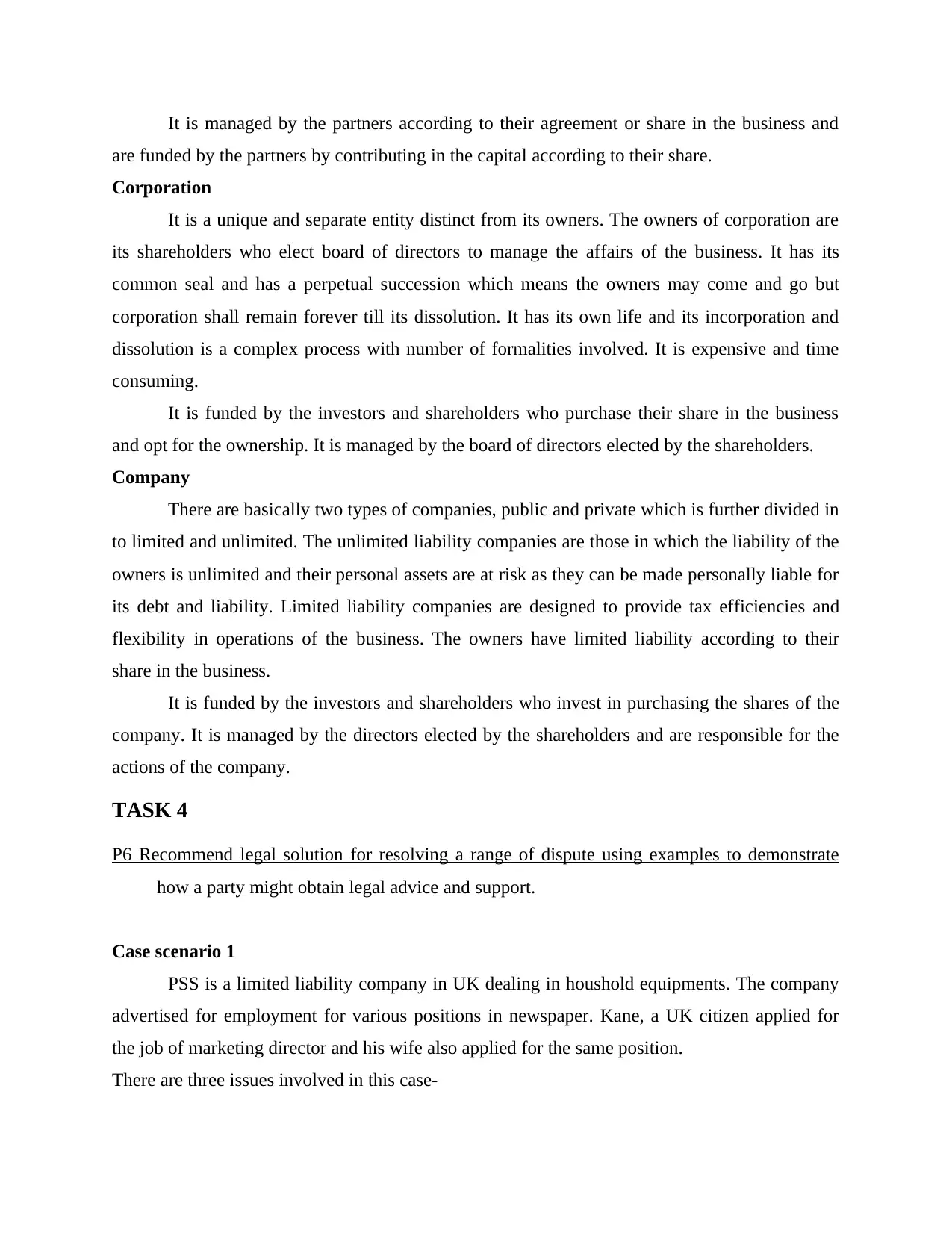
It is managed by the partners according to their agreement or share in the business and
are funded by the partners by contributing in the capital according to their share.
Corporation
It is a unique and separate entity distinct from its owners. The owners of corporation are
its shareholders who elect board of directors to manage the affairs of the business. It has its
common seal and has a perpetual succession which means the owners may come and go but
corporation shall remain forever till its dissolution. It has its own life and its incorporation and
dissolution is a complex process with number of formalities involved. It is expensive and time
consuming.
It is funded by the investors and shareholders who purchase their share in the business
and opt for the ownership. It is managed by the board of directors elected by the shareholders.
Company
There are basically two types of companies, public and private which is further divided in
to limited and unlimited. The unlimited liability companies are those in which the liability of the
owners is unlimited and their personal assets are at risk as they can be made personally liable for
its debt and liability. Limited liability companies are designed to provide tax efficiencies and
flexibility in operations of the business. The owners have limited liability according to their
share in the business.
It is funded by the investors and shareholders who invest in purchasing the shares of the
company. It is managed by the directors elected by the shareholders and are responsible for the
actions of the company.
TASK 4
P6 Recommend legal solution for resolving a range of dispute using examples to demonstrate
how a party might obtain legal advice and support.
Case scenario 1
PSS is a limited liability company in UK dealing in houshold equipments. The company
advertised for employment for various positions in newspaper. Kane, a UK citizen applied for
the job of marketing director and his wife also applied for the same position.
There are three issues involved in this case-
are funded by the partners by contributing in the capital according to their share.
Corporation
It is a unique and separate entity distinct from its owners. The owners of corporation are
its shareholders who elect board of directors to manage the affairs of the business. It has its
common seal and has a perpetual succession which means the owners may come and go but
corporation shall remain forever till its dissolution. It has its own life and its incorporation and
dissolution is a complex process with number of formalities involved. It is expensive and time
consuming.
It is funded by the investors and shareholders who purchase their share in the business
and opt for the ownership. It is managed by the board of directors elected by the shareholders.
Company
There are basically two types of companies, public and private which is further divided in
to limited and unlimited. The unlimited liability companies are those in which the liability of the
owners is unlimited and their personal assets are at risk as they can be made personally liable for
its debt and liability. Limited liability companies are designed to provide tax efficiencies and
flexibility in operations of the business. The owners have limited liability according to their
share in the business.
It is funded by the investors and shareholders who invest in purchasing the shares of the
company. It is managed by the directors elected by the shareholders and are responsible for the
actions of the company.
TASK 4
P6 Recommend legal solution for resolving a range of dispute using examples to demonstrate
how a party might obtain legal advice and support.
Case scenario 1
PSS is a limited liability company in UK dealing in houshold equipments. The company
advertised for employment for various positions in newspaper. Kane, a UK citizen applied for
the job of marketing director and his wife also applied for the same position.
There are three issues involved in this case-
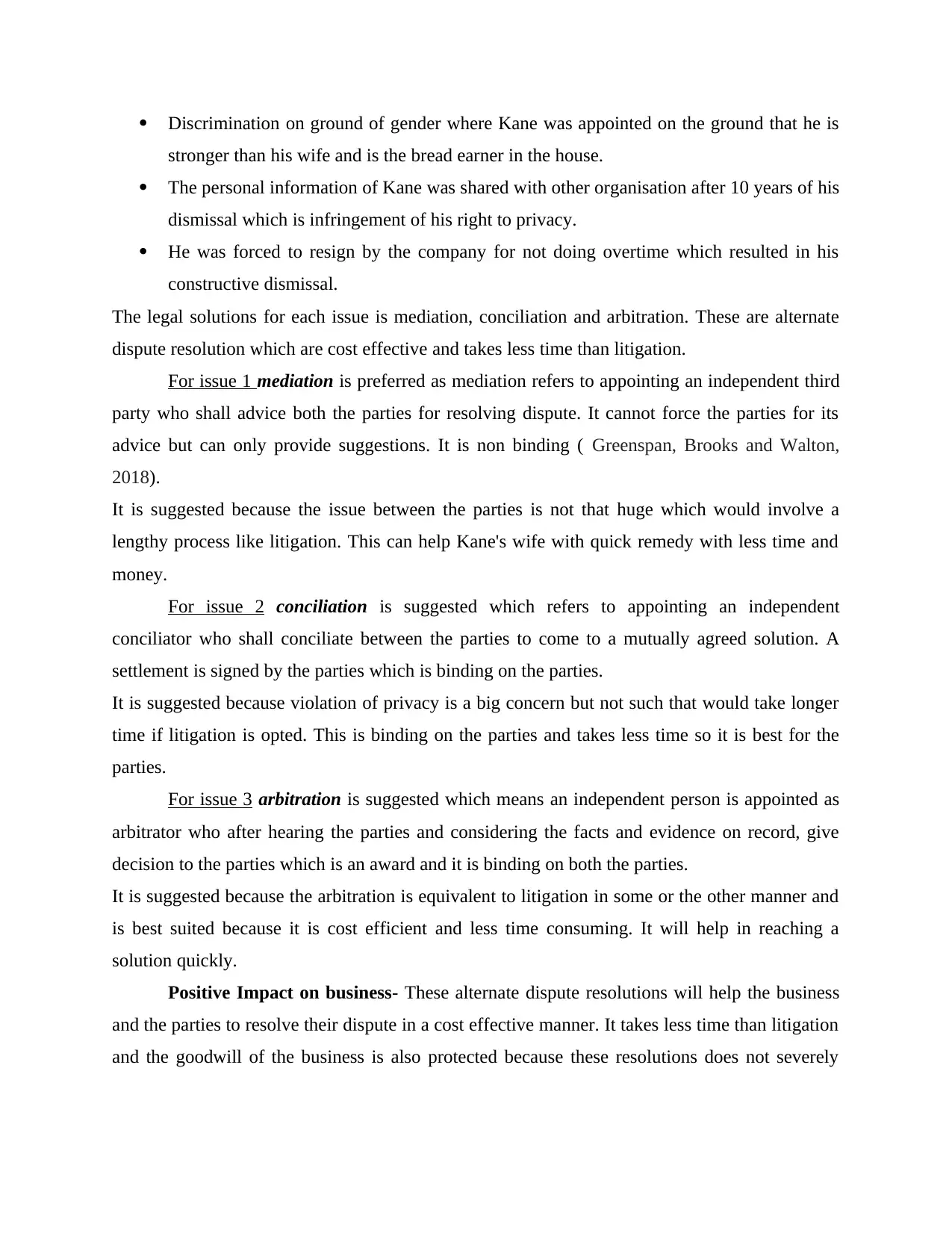
Discrimination on ground of gender where Kane was appointed on the ground that he is
stronger than his wife and is the bread earner in the house.
The personal information of Kane was shared with other organisation after 10 years of his
dismissal which is infringement of his right to privacy.
He was forced to resign by the company for not doing overtime which resulted in his
constructive dismissal.
The legal solutions for each issue is mediation, conciliation and arbitration. These are alternate
dispute resolution which are cost effective and takes less time than litigation.
For issue 1 mediation is preferred as mediation refers to appointing an independent third
party who shall advice both the parties for resolving dispute. It cannot force the parties for its
advice but can only provide suggestions. It is non binding ( Greenspan, Brooks and Walton,
2018).
It is suggested because the issue between the parties is not that huge which would involve a
lengthy process like litigation. This can help Kane's wife with quick remedy with less time and
money.
For issue 2 conciliation is suggested which refers to appointing an independent
conciliator who shall conciliate between the parties to come to a mutually agreed solution. A
settlement is signed by the parties which is binding on the parties.
It is suggested because violation of privacy is a big concern but not such that would take longer
time if litigation is opted. This is binding on the parties and takes less time so it is best for the
parties.
For issue 3 arbitration is suggested which means an independent person is appointed as
arbitrator who after hearing the parties and considering the facts and evidence on record, give
decision to the parties which is an award and it is binding on both the parties.
It is suggested because the arbitration is equivalent to litigation in some or the other manner and
is best suited because it is cost efficient and less time consuming. It will help in reaching a
solution quickly.
Positive Impact on business- These alternate dispute resolutions will help the business
and the parties to resolve their dispute in a cost effective manner. It takes less time than litigation
and the goodwill of the business is also protected because these resolutions does not severely
stronger than his wife and is the bread earner in the house.
The personal information of Kane was shared with other organisation after 10 years of his
dismissal which is infringement of his right to privacy.
He was forced to resign by the company for not doing overtime which resulted in his
constructive dismissal.
The legal solutions for each issue is mediation, conciliation and arbitration. These are alternate
dispute resolution which are cost effective and takes less time than litigation.
For issue 1 mediation is preferred as mediation refers to appointing an independent third
party who shall advice both the parties for resolving dispute. It cannot force the parties for its
advice but can only provide suggestions. It is non binding ( Greenspan, Brooks and Walton,
2018).
It is suggested because the issue between the parties is not that huge which would involve a
lengthy process like litigation. This can help Kane's wife with quick remedy with less time and
money.
For issue 2 conciliation is suggested which refers to appointing an independent
conciliator who shall conciliate between the parties to come to a mutually agreed solution. A
settlement is signed by the parties which is binding on the parties.
It is suggested because violation of privacy is a big concern but not such that would take longer
time if litigation is opted. This is binding on the parties and takes less time so it is best for the
parties.
For issue 3 arbitration is suggested which means an independent person is appointed as
arbitrator who after hearing the parties and considering the facts and evidence on record, give
decision to the parties which is an award and it is binding on both the parties.
It is suggested because the arbitration is equivalent to litigation in some or the other manner and
is best suited because it is cost efficient and less time consuming. It will help in reaching a
solution quickly.
Positive Impact on business- These alternate dispute resolutions will help the business
and the parties to resolve their dispute in a cost effective manner. It takes less time than litigation
and the goodwill of the business is also protected because these resolutions does not severely
⊘ This is a preview!⊘
Do you want full access?
Subscribe today to unlock all pages.

Trusted by 1+ million students worldwide
1 out of 16
Related Documents
Your All-in-One AI-Powered Toolkit for Academic Success.
+13062052269
info@desklib.com
Available 24*7 on WhatsApp / Email
![[object Object]](/_next/static/media/star-bottom.7253800d.svg)
Unlock your academic potential
Copyright © 2020–2025 A2Z Services. All Rights Reserved. Developed and managed by ZUCOL.




